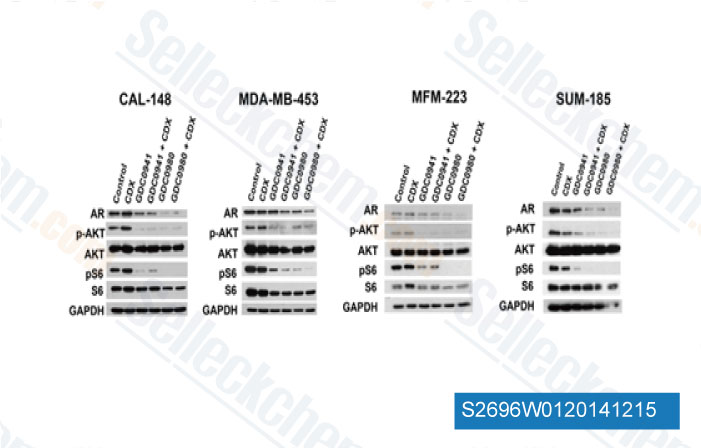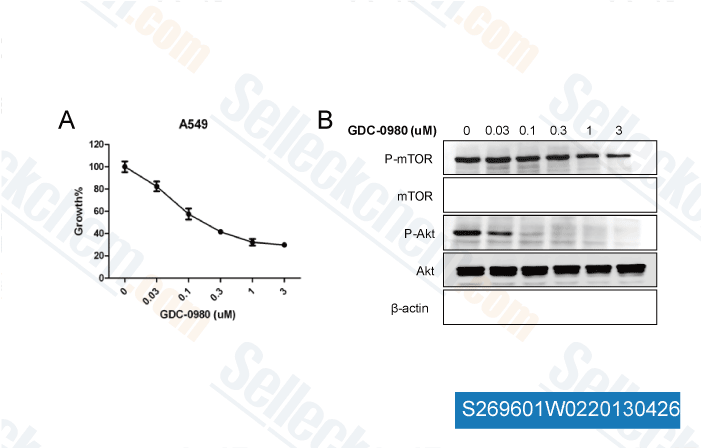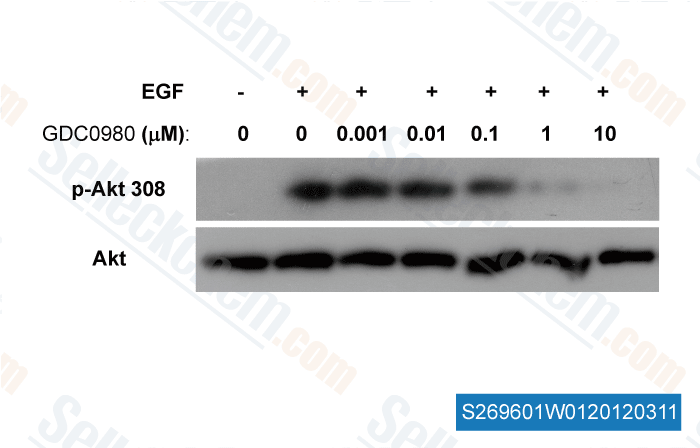|
How to Cite 1. For In-Text Citation (Materials & Methods): 2. For Key Resources Table: |
||
|
Toll Free: (877) 796-6397 -- USA and Canada only -- |
Fax: +1-832-582-8590 Orders: +1-832-582-8158 |
Tech Support: +1-832-582-8158 Ext:3 Please provide your Order Number in the email. We strive to reply to |
Technical Data
| Formula | C23H30N8O3S |
||||||
| Molecular Weight | 498.6 | CAS No. | 1032754-93-0 | ||||
| Solubility (25°C)* | In vitro | DMSO | 20 mg/mL (40.11 mM) | ||||
| Water | Insoluble | ||||||
| Ethanol | Insoluble | ||||||
| In vivo (Add solvents to the product individually and in order) |
|
||||||
|
* <1 mg/ml means slightly soluble or insoluble. * Please note that Selleck tests the solubility of all compounds in-house, and the actual solubility may differ slightly from published values. This is normal and is due to slight batch-to-batch variations. * Room temperature shipping (Stability testing shows this product can be shipped without any cooling measures.) |
|||||||
Preparing Stock Solutions
Biological Activity
| Description | Apitolisib (GDC-0980, RG7422, GNE 390) is a potent, class I PI3K inhibitor for PI3Kα/β/δ/γ with IC50 of 5 nM/27 nM/7 nM/14 nM in cell-free assays, respectively. It also acts as a mTOR inhibitor with Ki of 17 nM in a cell-free assay, and is highly selective versus other PIKK family kinases. This compound activates autophagy and apoptosis simultaneously in pancreatic cancer cells. Phase 2. | ||||||||||
|---|---|---|---|---|---|---|---|---|---|---|---|
| Targets |
|
||||||||||
| In vitro | Apitolisib (GDC-0980) shows potent and selective inhibitory activities against class I PI3K and mTOR kinase versus a large panel of kinases, with Ki of 17 nM for mTOR and IC50 of 5 nM, 27 nM, 7 nM, and 14 nM for PI3Kα, β, δ, and γ, respectively. [1] In vitro, this compound significantly inhibits cell proliferation in PC3 and MCF7 cells with IC50 of 307 nM and 255 nM, respectively. [1] A recent study shows that it reduces cancer cell viability by inhibiting cell-cycle procession and inducing apoptosis with most potency in prostate (IC50 < 200 nM 50%, <500 nM 100%), breast (IC50 <200 nM 37%, <500 nM 78%) and NSCLC lines (IC50 <200 nM 29%, <500 nM 88%) and less potency in pancreatic (IC50 <200 nM 13%, <500 nM 67%) and melanoma cell lines (IC50 <200 nM 0%, <500 nM 33%). [2] | ||||||||||
| In vivo | Apitolisib (GDC-0980) exhibits significant antitumor activity at a dose of 1 mg/kg by causing tumor growth delay in both PC-3 and MCF-7 neo/HER2 xenograft models. Furthermore, this compound results in tumor stasis or regressions at the maximum tolerated dose of 7.5 mg/kg. [1] In mice, intravenous administration at 1 mg/kg leads to low clearance (Clp: 9.2 mL/min/kg, Vss: 1.7 L/kg). While, oral administration at 5 mg/kg in 80% PEG400 and at 50 mg/kg as a crystalline suspension in 0.5% methylcellulose/0.2% Tween-80 also results in favorable pharmacokinetic parameters. [1] | ||||||||||
| Features | A potent, selective, and orally available inhibitor of PI3Kα, β, δ, γ and mTOR. |
Protocol (from reference)
| Kinase Assay:[1] |
|
|---|---|
| Cell Assay:[1] |
|
| Animal Study:[1] |
|
References
|
Customer Product Validation

-
Data from [ Breast Cancer Res , 2014 , 16(4), 406 ]

-
Data from [ PLoS One , 2014 , 9(9), e105919 ]

-
, , Dr.Wang Wei from NanFang Hospital

-
, , Dr. Zhang of Tianjin Medical University
Selleck's Apitolisib (GDC-0980) Has Been Cited by 34 Publications
| Depleting the action of EZH2 through PI3K-mTOR inhibition to overcome metastasis and immunotherapy resistance in triple-negative breast cancer [ Mol Cancer Ther, 2025, 10.1158/1535-7163.MCT-24-0693] | PubMed: 40497697 |
| Establishment, characterization, and biobanking of 36 pancreatic cancer organoids: prediction of metastasis in resectable pancreatic cancer [ Cell Oncol (Dordr), 2024, 10.1007/s13402-024-00939-5] | PubMed: 38619751 |
| Dual targeting of the androgen receptor and PI3K/AKT/mTOR pathways in prostate cancer models improves antitumor efficacy and promotes cell apoptosis [ Mol Oncol, 2024, 10.1002/1878-0261.13577] | PubMed: 38225213 |
| Ferroptosis heterogeneity in triple-negative breast cancer reveals an innovative immunotherapy combination strategy [ Cell Metab, 2022, S1550-4131-2200411-9] | PubMed: 36257316 |
| Distinctive molecular features of regenerative stem cells in the damaged male germline [ Nat Commun, 2022, 13(1):2500] | PubMed: 35523793 |
| Overexpression of S100A9 in obesity impairs macrophage differentiation via TLR4-NFkB-signaling worsening inflammation and wound healing [ Theranostics, 2022, 12(4):1659-1682] | PubMed: 35198063 |
| Cancer genes disfavoring T cell immunity identified via integrated systems approach [ Cell Rep, 2022, 40(5):111153] | PubMed: 35926468 |
| Therapeutic Targeting of Stromal-Tumor HGF-MET Signaling in an Organotypic Triple-Negative Breast Tumor Model [ Mol Cancer Res, 2022, 20(7):1166-1177] | PubMed: 35348758 |
| Identification of New Vulnerabilities in Conjunctival Melanoma Using Image-Based High Content Drug Screening [ Cancers (Basel), 2022, 14(6)1575] | PubMed: 35326726 |
| Culture and multiomic analysis of lung cancer patient-derived pleural effusions revealed distinct druggable molecular types [ Sci Rep, 2022, 12(1):6345] | PubMed: 35428753 |
RETURN POLICY
Selleck Chemical’s Unconditional Return Policy ensures a smooth online shopping experience for our customers. If you are in any way unsatisfied with your purchase, you may return any item(s) within 7 days of receiving it. In the event of product quality issues, either protocol related or product related problems, you may return any item(s) within 365 days from the original purchase date. Please follow the instructions below when returning products.
SHIPPING AND STORAGE
Selleck products are transported at room temperature. If you receive the product at room temperature, please rest assured, the Selleck Quality Inspection Department has conducted experiments to verify that the normal temperature placement of one month will not affect the biological activity of powder products. After collecting, please store the product according to the requirements described in the datasheet. Most Selleck products are stable under the recommended conditions.
NOT FOR HUMAN, VETERINARY DIAGNOSTIC OR THERAPEUTIC USE.
